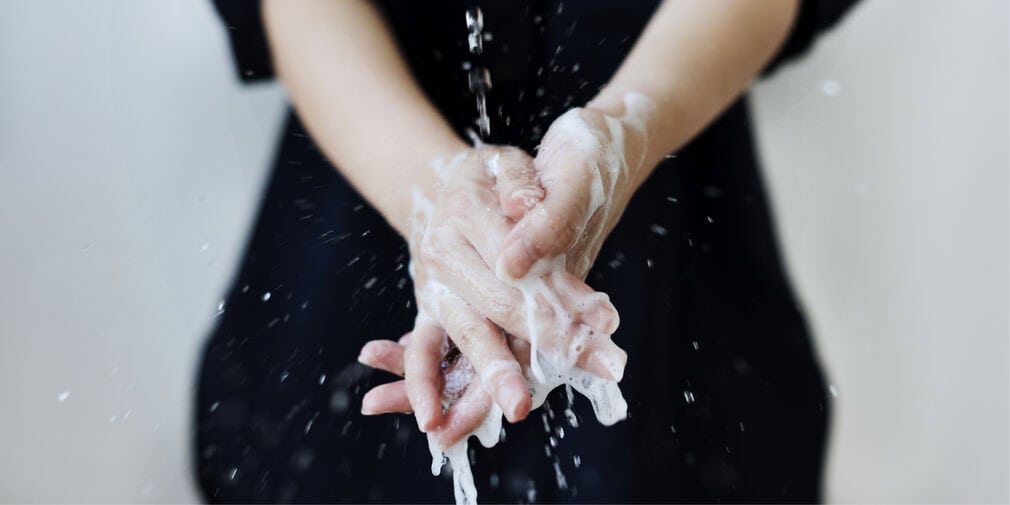Do you know which components of your restaurant kitchen’s hot water infrastructure are regulated under the FDA’s Food Code?
The U.S. Food and Drug Administration’s Code sets the guidelines for each state’s food codes and specifies restaurant hot water requirements for warewashers and sinks. Every food service establishment must understand these critical components of food sanitation. Your commercial water heater plays a vital role in keeping your doors open to the public, so let’s make sure your water heating system is up to code!
As a restaurant owner, you use hot water daily in your kitchen. The average restaurant uses two gallons of hot water per meal served (if not more), and the temperature of that water plays a specific role in maintaining sanitary conditions. Here’s an overview of some of the most common ways that hot water is used in a restaurant:

Sanitation: Not only is good sanitation the law, but it’s best practice to have a clean kitchen facility. Clean and sanitized equipment, dishes, and surfaces reduce the risk of foodborne illness caused by bacterial growth. You want to be recognized for your amazing food, competent waitstaff, and unique ambiance – not a track record of food poisoning.
Hand Washing: Your staff should be trained in proper personal hygiene for handling and serving food. Aside from not coming to work sick, staff must know how frequently and thoroughly to wash their hands. It might seem like a job for an elementary school teacher, but if your staff are touching food with their unclean hands, they could be spreading foodborne illnesses.
Washing Dishes: Common sense tells us that no one wants to eat off of a dirty dish, and your staff isn’t likely to send one through the line and out to a table. However, bacteria aren’t visible to the naked eye. The only way to ensure that your dishes are truly clean is to run them through a sanitizing commercial dishwasher (warewasher), which requires very hot water and sanitizing chemicals. You’ll need to select a washing option that fits your restaurant’s system requirements.
Cleaning Your Equipment: It’s always best to wipe down surfaces and equipment with a clean rag and detergent. Anyone who has cleaned up a much-used surface, like those in a restaurant kitchen, knows hot or warm water will be more effective than cold water for removing stains, spills, and even burnt-on messes.
Washing The Floors: Similar to cleaning a counter with warm water, you’ll achieve better results by removing any sticky residue or gunk from those hard floors with plenty of hot water in your mop bucket.
Turning Up the Heat: Sanitizing Dishwashers
To revisit our earlier statistics, of the two gallons of hot water used per meal, 1.6 gallons, or 80%, of this water is used during peak dishwashing time. To comply with local health codes, your restaurant’s hot water system must be capable of producing and storing sufficient water to meet the needs during your peak dishwashing times.
In the world of commercial dishwashers, also known as warewashers, restaurants have two options to choose from for passing a health inspection. Your restaurant can use a high-temp warewasher that uses hot water for sanitizing, or you can use a low-temp warewasher, which requires chemicals to get the job done. As with most things, there are pros and cons of each option.

To sanitize your dishes and equipment in a commercial warewasher with hot water, the water used during the wash cycle must be heated to between 150°F and 160°F, depending on the specific type of high-temperature warewasher. Here is the wording from the Food & Drug Administration’s Food Code, which most health departments use for their guidelines:
“4-501.110 Mechanical Warewashing Equipment, Wash Solution Temperature.
(A) The temperature of the wash solution in spray-type warewashers that use hot water to SANITIZE may not be less than:
(1) For a stationary rack, single temperature machine, 74o C (165o F); Pf
(2) For a stationary rack, dual temperature machine, 66o C (150o F); Pf
(3) For a single tank, conveyor, dual temperature machine, 71o C (160o F); Pf or
(4) For a multitank, conveyor, multi-temperature machine, 66o C (150o F). Pf
(B) The temperature of the wash solution in spray-type warewashers that use chemicals to SANITIZE may not be less than 49o C (120o F). Pf”
Most importantly, there are specific requirements for the rinse cycle, during which the actual sanitizing occurs. Water temperature must enter the machine at a blistering 180°F. Again, the Food Code states:
“4-501.112 Mechanical Warewashing Equipment, Hot Water Sanitization Temperatures.
(A) Except as specified in ¶ (B) of this section, in a mechanical operation, the temperature of the fresh hot water SANITIZING rinse as it enters the manifold may not be more than 90o C (194o F) or less than: Pf
(1) For a stationary rack, single temperature machine, 74o C (165o F); Pf or
(2) For all other machines, 82o C (180o F). Pf
(B) The maximum temperature specified under ¶ (A) of this section, does not apply to the high pressure and temperature systems with wand-type, hand-held, spraying devices used for the in-place cleaning and SANITIZING of EQUIPMENT such as meat saws.”

The Reasoning Behind These Codes
Here’s the logic behind these two codes: germs, bacteria, and other microorganisms won’t survive on dishes heated to 180°. Research has shown that heating the rinse water to 180° will produce a dish surface of 160° – hot enough to kill the nasty stuff. However, it’s much easier to heat a cold dish to that 160° temperature if those dishes spend a bit of time in a wash cycle heated to 150° or 160 °. It’s also important that your hot water sanitizing cycle not exceed 195° because food particles may actually “bake” into your dishware at such extreme temperatures.
One thing you should never do is set your restaurant’s water heater to 160°F for sanitation purposes. While this is not a good idea for many reasons, in this case, the water temperature is insufficient for sanitizing. Your primary hot water heater’s thermostat might reach that high, but doing so could result in severe burns when the hot water supply is used for tasks like hand washing.
If you choose the hot water sanitizing method, you’ll want to make sure you’ve got a booster heater installed as part of your operation. A booster heater will help you safely reach the minimum hot water temperatures for sanitization while keeping your hands – and the hands of your staff and customers – clean and scald-free.
Your warewashing machine should come equipped with a data plate affixed somewhere on the machine that indicates the temperatures reached and the time required for the wash cycle. These requirements are also laid out in the Food Code. Even so, it’s recommended that you test the water in your warewasher periodically to be sure your equipment is functioning properly. Your state and locality may require documentation of the hot water temperature used by food establishments for sanitizing purposes during an inspection, so be sure you know what proof they may ask you to provide.
If you opt for the chemical sanitizing option, the water in your low-temperature warewasher must reach a minimum temperature of 120° (you’ll have better luck getting grease off those dishes at a temperature closer to 135°).

Employees Must Wash Hands Before Returning to Work
Equipment sanitization is not the only place hot water is required in food service establishments. Personal hygiene and clean hands are also extremely important. In fact, the FDA Food Code also regulates the temperatures required for hand washing in commercial kitchens. The specific code states:
“5-202.12 Handwashing Sink, Installation.
(A) A HANDWASHING SINK shall be equipped to provide water at a temperature of at least 38o °C (100 °F) through a mixing valve or combination faucet. Pf”
Note: The minimum temperature required for a handwashing sink was previously 120°F, but it has been lowered to reduce the risk of scalding injuries.
Remember, if your restaurant has a bar area, you’ll need an additional hand sink for the bar, one that is separate from the back of the house. Since drinkware and bar equipment are often washed regularly during service using a sink at the bar, sanitizing detergent or solutions must be used to keep these items clean in between washes in the commercial warewasher.
Setting Up a New Restaurant Kitchen?
If you are in the process of designing your restaurant’s kitchen, this is the ideal time to start considering your water heating system. In order to make sure your restaurant is equipped with the proper setup, begin by making a list of the fixtures and appliances that will require hot water. From there, you can work backward to determine how much hot water you will need and how hot your water needs to be. This process will also help you determine whether you need additional equipment, such as booster heaters.
Water heater sizing is best left to the professionals, so don’t try to figure it all out on your own. If you begin by simply choosing a water heating system without careful consideration, you could be left with food safety violations and no hot water when you need it most.
Depending on your kitchen setup and your local regulations, you may have some or all of the following:
- Restroom sinks
- Hand sinks
- Bar sink
- 3-comp sink
- Dishwasher (door-type or conveyor)
- Pre-rinse valve
- Mop sink
- Utility and Prep sinks
- Dipper well
- Automatic pot washer
Don’t forget to consider the late-night cleaning demands when evaluating your hot water needs. Hosing down floors, filling up mop buckets, and filling large sinks can use massive amounts of hot water simultaneously.
Reliable hot water distribution systems, well-built and well-maintained, are essential for restaurant owners who require hot water on demand. You also need to ensure that your restaurant’s hot water system can consistently meet your cleaning demands and the minimum temperature requirements for sanitation outlined in the FDA’s Food Code. Doing so will help you breeze through your health inspections with four stars and keep your customers coming back for more.
Staying informed about the hot water usage in your restaurant helps you stay in business!